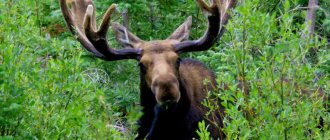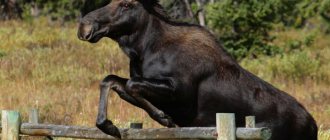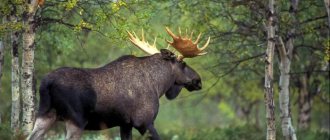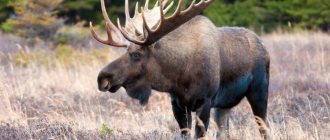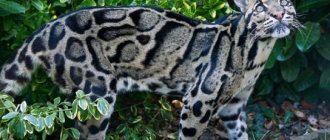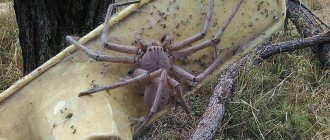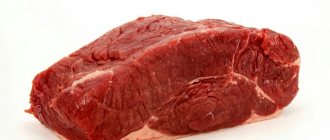I made my way through a tall damp forest in the middle reaches of the Omolon River. The thick foliage under my feet muffled the sounds of my steps. A cloth jacket, cotton trousers and boots with soft rubber soles made the progress almost silent. Nevertheless, I had to be very careful so that the branch did not snap. I carefully pressed my foot into the foliage, trying to rest on solid ground. If he felt a springy branch, he quickly removed his foot and looked for a more reliable place.
From the approach
The branches cracked a hundred and fifty meters away from me. Judging by the sounds, an elk was feeding in the thicket of the Omolon urema, and it is possible that more than one. Most likely, there was an elk standing there with a female and, possibly, last year’s cub.
Three days ago, from the slope of a hill hanging over the river, I managed to see a male with a luxurious crown of horns with a span of at least 160 cm. But while I was going down and getting my bearings in the tangle of channels hidden among the forest, the animal managed to go quite far. At least his tracks were lost among many other moose tracks.
Yesterday, contrary to all the laws of nature, at the very end of September, wet snow began to fall, turning into rain. And my hopes of luring this stag with a roar came to nothing at once. Elks of northeastern Siberia practically do not roar and do not roar in bad, especially humid and warm weather. But this weather gave me another very important chance - to successfully approach the animal during feeding.
Elk, especially during the rut, is a rather noisy animal. It makes sounds literally with its whole body - it touches branches, hits tree trunks with its horns, and a very characteristic bone knock is heard. Yes, and he walks quite hard. But it creates the most noise during feeding, when from time to time it breaks off branches - this crunching sound spreads through the quiet forest for almost half a kilometer. When you hear the cracking of more than two branches in a row in one place, you understand that there is a very high probability that you have approached a feeding elk (or even a whole group).
Here the actual hunt begins, just as exciting as on a capercaillie lek, only much more complex and responsible. The fact is that, although the elk makes quite a lot of noise itself, it does not go deaf like the capercaillie. On the contrary, his large ears, like radars, constantly scan the space 360 degrees around.
In addition, moose try to stay in groups, and the noisiest, naturally, is the largest and
the horniest of them all. The hunter approaches him, focusing on the cracking of branches and other accompanying sounds. But quite often on the way, without knowing it, he comes across a moose cow or her one-year-old offspring, who immediately raise the alarm, and the entire horned family goes into the thicket...
And now, out of the corner of my eye, I notice some movement to my right. I freeze, cross my eyes and see a medium-sized female slowly plucking a clump of willow. She doesn't notice me, but it doesn't last long - all I have to do is move, and her sensitive ears will warn her about the appearance of a stranger.
From me to the moose, or, as Siberian industrialists call the females, cows, it’s about seventy meters. And the noise made by the male is heard about a hundred meters somewhere ahead, in an impassable thicket.
I take risks and take a step forward. But trouble comes from a completely different direction. It turns out that while I was looking sideways at the moose, I was already being watched by her cub, who, just like me, froze, but from the other side - to the left, thirty meters away. Moving very quietly, I found myself right in the middle of a moose family’s feeding area, and now all the animals became alert at once.
The cow was the first to break down. She made a strange chirping sound, and the forest immediately exploded with a crash and roar. Eagles are rather secretive animals, but they do not know how to run silently in the forest. The male was the first to rush like a torpedo, followed by the female and the cub. For a moment, huge horns, glistening with moisture, appeared, and... Everything became quiet... Today is not fate...
Interesting Facts
Moose are unique animals. Indeed, in addition to their gigantic size, they have a number of other unusual features:
- In water they can swim at speeds of up to 10 km/h, dive to a depth of 5 meters and hold their breath for up to 1 minute.
- Thanks to their strong, long legs, animals can run at speeds of up to 56 km/h.
- The special structure of their eyes allows them to notice the movement of objects behind them without turning their head.
- They are not able to see a motionless person if he is at a distance of several tens of meters.
- They can rotate their ears in all directions and hear sounds made by their relatives even 3 km away.
- Very long legs cause them significant inconvenience when drinking. To quench its thirst, the animal has to go deep into a pond or kneel down.
- The animal's main weapon is not its horns, but its front legs, the blow of which can be fatal even for a bear.
- They love to feast on rotten apples because the fermentation process gives them a feeling of euphoria.
Rare white moose filmed by Swedish explorer Hans Nilsson
4.5 / 5 ( 4 voices)
Who is the giant moose?
Throughout the entire northern hemisphere of the Earth, moose is one of the most enviable trophies among ungulates. However, few people know that these animals are very different from each other and that the elk of the North of Finland is completely different from the elk from the Yenisei, and the stag elk of the Amur region will look completely different next to these two. But in the list of trophies, a very special place is occupied by Kamchatka and Alaskan moose, which are very similar to each other in size, appearance, scope and character of the horns. Today, these animals are rightfully considered the largest deer on the globe.
The giant moose of Kolyma and Alaska have a common place of origin. It is located where the waves of the Bering Sea rage today. Once upon a time there was land here, which paleogeographers who study very ancient times usually call Beringia. A large river similar to the modern Yenisei or Lena flowed through the territory of Beringia; one of its tributaries was the modern Anadyr, and the other was the modern Yukon. It was in the basin of this great “fossil” river that a race of moose appeared, which today are commonly called “giant”.
The famous Russian weapons expert S. Buturlin was the first to notice the similarity between the Kolyma and Alaska moose. During his Kolyma expedition, he extracted more than two hundred stags from a double-barreled “paradox” 24-caliber Ivashentsov system, which was made by the talented gunsmith F. Matskoy according to Buturlin’s order and calculations.
By the way, initially giant moose never lived on the Kamchatka Peninsula. They were acclimatized there by specialists from the Central Scientific Research Laboratory of Glavohoty of the RSFSR in the early 80s of the 20th century. And they brought elk to the valley of the Kamchatka River from the Anadyr basin. Therefore, scientists call this subspecies of moose not giant or Kamchatka, but East Siberian. And in Latin he bears the name of the famous moose killer Buturlin...
The live weight of a giant moose ranges from 450 kg (adult female) to 810 kg (huge male). The span of the horns reaches 193 cm; there can be 38-40 branches on both shovels. I must immediately note that no one, I repeat, no one (!), has yet been able to reliably catch an elk with two-meter horns.
So the East Siberian, or giant, elk is a completely separate race of elk, living in a very limited area of Russia. This animal inhabits the basins of Anadyr, Penzhina, Upper and Middle Kolyma and Indigirka. As mentioned above, it is acclimatized by humans on the Kamchatka Peninsula.
Moreover, even the coastal territories of Kolyma are far from evenly populated by giant elk. This race lives only in its middle and lower reaches - in Yakutia and adjacent areas of the Magadan region. And the upper reaches of the Kolyma are inhabited by other elk, which are intermediate between the East Siberian and Ussuri subspecies. These same moose, which are of little interest to trophy hunters, also live on the rivers of the Okhotsk coast west and south of Gizhiga.
Males lose and grow antlers every year
The males' horns extend almost 1.8 meters from tip to tip. Moose shed and regrow their antlers every year. Antlers are a sign of dominance and help males protect their eyes when fighting other moose. They sometimes spray urine on their antlers to lure females to mate.
- How much does an elk weigh, depending on the region?
The horns have a bony base and are covered with soft skin called velvet. They develop quickly, growing up to 20 cm in nine days. Before the mating season in September, males experience a surge of testosterone, which causes the velvet to molt and the antlers to become bare.
Hunting process
Trophy hunting for giant moose in Eastern Siberia is carried out either “on the waboo” or in a pen. During the “wabu” hunt, the jacker imitates the voice of an inexperienced young but persistent bull or cow. Naturally, all males in a row respond to the call of a female, but almost exclusively trophy specimens respond to the roar of a young bull. Moreover, when luring with a roar, the animal can appear very close to the hunter - literally in a few meters, which in itself makes a very strong impression.
Roundup hunts for this animal are fundamentally different from standard roundup hunts in Eastern and Central Europe. They are often attended by only two beaters and two shooters, and sometimes even two – a beater (also known as a guide) and a shooter. For the corral, a small area of the river floodplain is selected, limited on all sides by open spaces (channels or pebbles). The guide-guide places the shooter on the most likely path of the animal, and he himself goes deeper into the forest, where he slowly “moves” the elk towards the shooter - so that the alarmed animal, on the one hand, does not rush headlong, and on the other, does not decide that a person walking in the forest is safe for him, and did not bypass him, remaining in the thicket.
In a number of cases, you can see moose during the day from the slope of some hill and then, having determined their probable location, try to catch them in one way or another. Approach hunting, the description of which I began my story with, is practiced by very few people. It cannot be recommended for hunting trophy animals. First of all, because during trophy hunting, two shooters approach the animal - the athlete and the accompanying person. This means they produce twice as much noise. Therefore, the animals hide before they can be noticed.
The process of extracting them with dogs is also not successful in trophy elk hunting. The fact is that a large male, frightened by dogs, usually leaves without looking back, “on the fly,” leaving the female and her offspring to “sort out on the spot.”
The biggest frog
The largest frog is the Goliath frog, found in Cameroon. Its body length (excluding paws) is more than 30 cm, and its weight is more than 3 kg.
Interesting fact. The Goliath frog is an endangered species of animal. Reasons: the advance of civilization on its habitats and capture for sale. They sell goliath frogs to collectors and restaurants; the cost of one animal is $5. The meat of these frogs is tasty, plus Cameroonians consider them “clean” animals necessary for the nutrition of pregnant women.
How many of them are there, giant moose?
Throughout the entire historical period of time, the Russian peasant, who appeared in the northeast of Siberia in 1648, shot elk. And he did it quite successfully. The first Cossack bands appeared in Anadyr in 1650. As their “fairy tales” and “submissions” testify, they caught up to two hundred elk per year. And at the end of the 19th century, Colonel Olsufiev, traveling on official business in the Anadyr region, no longer found moose in the basin of the river of the same name. Little by little they began to appear there in the middle of the 20th century. And in the second half of the same century there was a sharp jump in their numbers on the outskirts of their range.
In the early 70s, my father, taking into account the elk from the plane in the same Anadyr, estimated their number at 400 individuals. 15 years later, in 1984, I myself had to take part in similar work. And there were already ten times more elk - about 4 thousand!
Today in northeastern Siberia there are about 30 thousand heads of giant moose. Of this stock, only about 10% can be considered suitable as a trophy. So the trophy potential of this moose subspecies in Eurasia is very, very limited. And, characteristically, these animals live in the most inaccessible areas of the most sparsely populated region of the world.
What should we shoot at him with?
A Russian man hunted a giant elk quite successfully for almost 400 years and, I must say, shot it with anything. The flint fuses of the gangs of Mikhail Stadukhin and Fedot Popov (the same one in whose detachment the famous Semyon Dezhnev served) were of a relatively small caliber for that time (no more than 5-7 lines), like most of the then Siberian rifles. This was explained by the fact that lead far from, as they would be called now, supply bases was practically inaccessible to forward detachments. Moreover, it was precisely to save lead that local residents quite successfully hunted elk with a spear and caught them in snares.
In general, the giant elk is significantly inferior in strength “to the wound” and endurance not only to such recognized
champions, like the wild boar and bear, but even reindeer and their own brother - the European moose. He is stopped in his tracks by a bullet from any more or less suitable cartridge that hits the kill zone. I consider modern cartridges of caliber from 8.5 mm with a muzzle velocity of 650 m and weight from 15 g to be suitable. Naturally, the first in their series is the world-recognized 9.3x62, which has a huge number of equipment options. I recommend using 15 gram bullets for this hunt with a muzzle velocity of about 800 m/s. The fact is that in moose habitats - floodplains of rivers with vast expanses of pebbles and wastelands overgrown with low willow undergrowth - it may happen that you will have to shoot at a distance of both 80 and 300 meters.
Today, the .338 Win cartridge is very popular among sports hunters who come to hunt a giant elk. Mag. This is also a very good choice, providing high power with a relatively flat trajectory. I consider TUG, Nosler and Barnes all-metal bullets to be the best bullets for shooting not only elk, but generally all large animals in eastern Russia.
As for high-power cartridges, which, in the opinion of many, have an overkill effect (.375 H&H Magnum, .416 Rigby, etc.), I, of course, welcome the desire of hunters to shoot animals with weapons chambered for maximum destructive power, but...
There are a few “buts” here, I apologize for the pun.
Firstly, the overkill effect, from my humble point of view, is present only in the hunting imagination. When a cartridge reaches a certain power for shooting at a certain animal, the radius of the guaranteed kill zone required to stop the animal changes very little or does not change at all. In short, shot in the belly - either with a .30-06 Springfield or .416 Rigby cartridge - an elk will go on its five kilometers. At the same time, if it hits the heart area (if it is not hit), a beaten .30-06 Springfield animal will run 400 meters, and a .416 Rigby will fall on the spot. But it will fall in the same way if shot with both 9.3x62 and .338 Win. Mag. In addition, large-caliber and high-power cartridges are more expensive. And even if the price of ammunition for a hunter-sportsman is not of decisive importance, then training with a certain gun under the required cartridge is of this importance! And for exercises with weapons under 9.3x62 and under .375 H&H, different physical preparation is required!
But what you definitely shouldn’t use to shoot a giant moose is a weapon chambered for a caliber of less than 6.5 mm.
I remember such an episode. A friend of mine was fishing for grayling in the Omolon basin. For fishing, he took a Bars carbine loaded with Deer cartridges with a full-shell bullet weighing 2.5 g and an initial speed of 1110 m/s. Across the rift, sixty meters from him, he saw a large moose leisurely crossing the river.
The hunter shot the animal several times in the middle of the neck with a carbine. The giant twitched its skin several times where the bullets hit and just as slowly disappeared into the thickets. An acquaintance of mine followed his trail for half a kilometer, became convinced that the elk was behaving completely normally, and stopped the pursuit. The next day he hunted down this elk with a 16-gauge double-barreled shotgun and caught him lying down.
When cutting it up, it was discovered that all the bullets hit a circle with a radius of the palm. The neck was one continuous hematoma. And what? Not a single bullet reached the spine!
Hence the advice: use the right weapon in the right way - and luck will smile on you!
Author, photo: Mikhail Kretschmar

